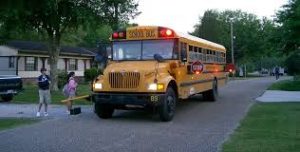A lot of people are confused on where and when people are supposed to stop for school buses in Seattle. Some people believe that oncoming traffic doesn’t have to stop but the cars behind the bus do have to stop. When do you have to stop for school buses?
 According to RCW 46.61.370 and SMC 11.53.440, you must stop for school buses if you are traveling behind the school bus no matter the type of road or highway you are on if the school bus driver has their amber stop sign out and flashing. If you are going the opposite direction of the school bus, you must stop for the school bus on all roads except those divided by a barrier or roads with three or more lanes or traffic going each direction.
According to RCW 46.61.370 and SMC 11.53.440, you must stop for school buses if you are traveling behind the school bus no matter the type of road or highway you are on if the school bus driver has their amber stop sign out and flashing. If you are going the opposite direction of the school bus, you must stop for the school bus on all roads except those divided by a barrier or roads with three or more lanes or traffic going each direction.
Stopping for school buses is for the safety of the children on the bus that need to cross the street to get to their house or get onto the bus. Not stopping for buses creates a danger where young children may run into the street and possibly get hit by a car causing a car accident to the young pedestrian. Stopping for school buses helps avoids pedestrian car accidents to young children and preventing significant injuries suffered in Seattle car accidents.
Fines for not stopping for a school bus with a stop sign out on the bus are double and are $419 in King County.
The Seattle school district along with others school districts in King County have installed high resolution cameras on their school bus stop signs to take pictures of license plates of cars that do not obey the stop sign of school buses. The pictures are sent to King County Sheriff to enforce.
During a pilot program last year, Seattle school district officials said they recorded nearly 600 vehicles passing a stopped school bus over 112 school days. While it’s against the law to pass a stopped bus, bus drivers don’t have time to record license-plate numbers and other information on their own.
Except as provided in subsections C and D of this section, the driver of a vehicle upon overtaking or meeting from either direction any school bus which has stopped on a roadway for the purpose of receiving or discharging any schoolchildren shall stop the vehicle before reaching such school bus when there is in operation on the school bus a visual signal as specified in Section 11.82.520 and the driver shall not proceed until such school bus resumes motion or the visual signals are no longer activated.
B.
The driver of a school bus shall actuate the visual signals required by Section 11.82.520 only when the school bus is stopped on a roadway for the purpose of receiving or discharging schoolchildren.
C.
The driver of a vehicle upon a street divided into separate roadways as provided in Section 11.53.080 need not stop upon meeting a school bus which is proceeding in the opposite direction and is stopped for the purpose of receiving or discharging schoolchildren.
D.
The driver of a vehicle upon a street with three (3) or more marked traffic lanes need not stop upon meeting a school bus which is proceeding in the opposite direction and is stopped for the purpose of receiving or discharging schoolchildren.
E.
The driver of a school bus may stop completely off the roadway for the purpose of receiving or discharging school children only when the school children do not have to cross the roadway. The school bus driver shall actuate the hazard warning lamps a defined in RCW 46.37.215 before loading or unloading school children at such stops.
F.
No school bus shall stop on an arterial street at a location other than an intersection, except at designated bus zones, passenger load zones, school loading zones, or load and unload zones for the purpose of receiving or discharging schoolchildren; provided, that school buses receiving or discharging handicapped, impaired or disabled students may stop at the most advantageous location for loading and unloading. (RCW 46.61.370)
(Ord. 119011 § 13, 1998: Ord. 108200 , § 2(11.53.440), 1979.)
RCW 46.61.370
Overtaking or meeting school bus, exceptions—Duties of bus driver—Penalty—Safety cameras.
Driving on divided highways.
